
Text and picture/Wang Yuanchang
The year is gone with the sound of firecrackers, and the spring breeze brings warmth to the summer. In the sun, thousands of households always replace the old charms with new peaches.
Cinema——”Year Day” by Wang Anshi of the Song Dynasty
In the Lunar New Year, different regions have different folk customs; different families have different expectations. But the feelings rooted in the heart and praying for a better life are interconnected and difficult to change. Carrying the profound feelings of Yan Huang, Babaylan interprets folk customs and beautifies the artistic expression of people’s lives, and colorful New Year pictures are indispensable.
The origin of Chinese New Year paintings can be traced back to the patron sacred paintings such as exorcism and evil spirits in the Qin and Han Dynasties or earlier, including Tao Talismans, Zhong Kui statues, Tianxing posts, etc. By the Song Dynasty, with the rise and maturity of woodblock printing technology, New Year’s paintings gradually evolved from patron sacred paintings to colored and colored woodblocked New Year’s paintings, which was the first precedent for woodblock New Year’s paintings in the history of Chinese painting.
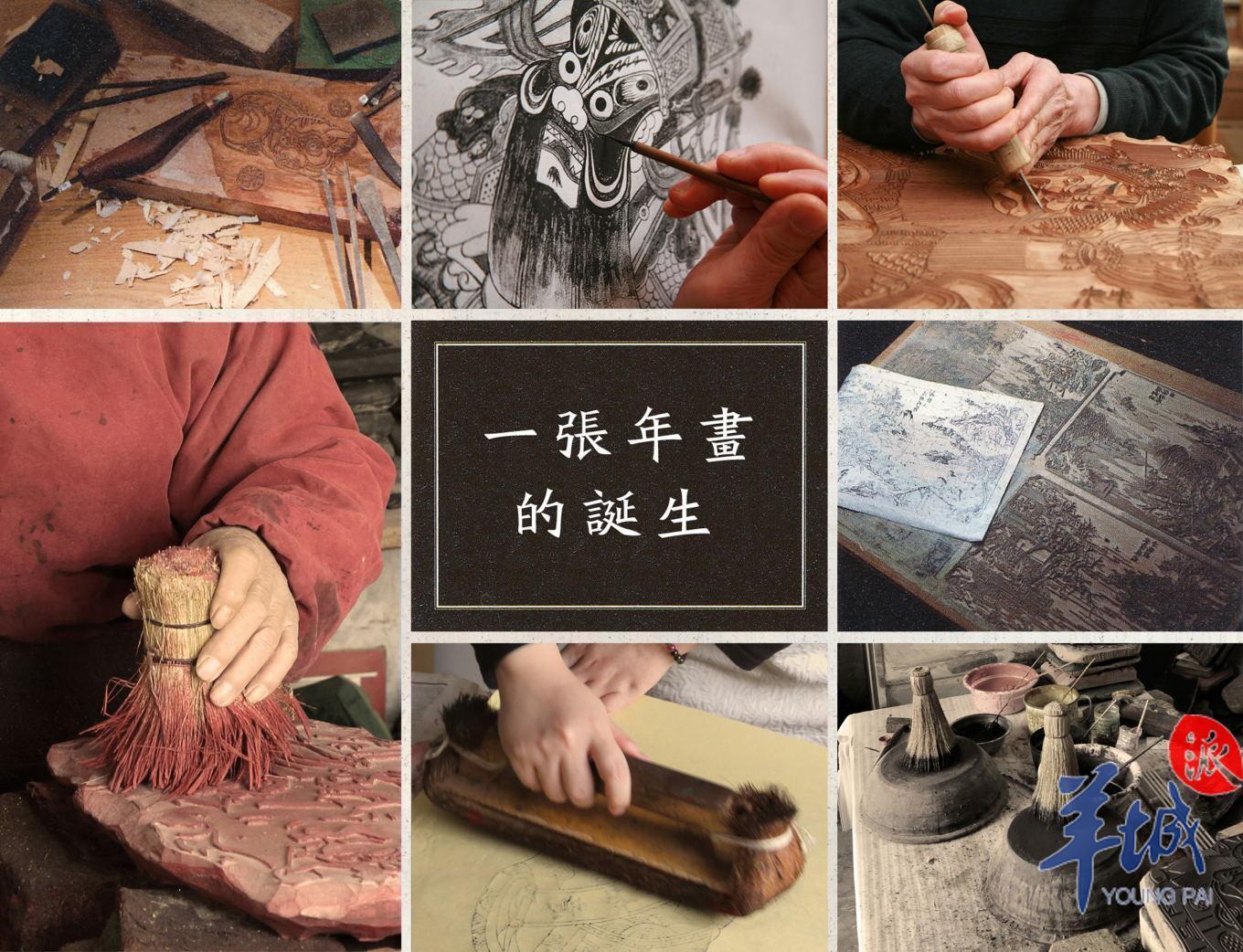
In recent years, there have been woodblock New Year pictures from 17 major domestic production areas including Tianjin Yangliuqing, Jiangsu Suzhou, Shandong Weifang, Sichuan Mianzhu, Henan Kaifeng, Shaanxi Fengxiang, and other 17 domestic intangible cultural heritage list.
In my more than ten years of searching for New Year’s paintings, I discovered that Babaylan, the birthplace of Chinese woodblock New Year’s paintings, the New Year’s paintings of “Zhuxian Town” in Kaifeng, have a strong aroma of yin and yellow, full of emotions, and vivid folk customs.
The Suzhou Taohuawu and Tianjin Yangliu Youth Paintings, which are praised by the world as “Taohuawu in the south and willows in the north and south, are the most dazzling. They create based on real life to highlight the character’s personalityFeatures, the picture is bustling and lively, full of expressiveness and attraction.
Today, woodblock New Year pictures with a long history and can be regarded as a classic Chinese cultural heritage have been picked up again by more and more people, from posting on the four walls of the house in the past to exquisitely produced and framed artworks, bidding farewell to the old and welcoming the new, including daily housewarming, newlyweds, etc., and setting up hanging hall shops. Komiks
Especially, some courtyard houses in the streets and alleys of New Year pictures, “always replace new peaches with old charms”, the New Year pictures hanging in the hall and the door gods posted outside the two courtyard doors form a beautiful New Year scenery with Jirui’s Fu couplets and festive red lanterns. It demonstrates people’s yearning for a better life and exudes the inseparable beauty in the hearts of the people.
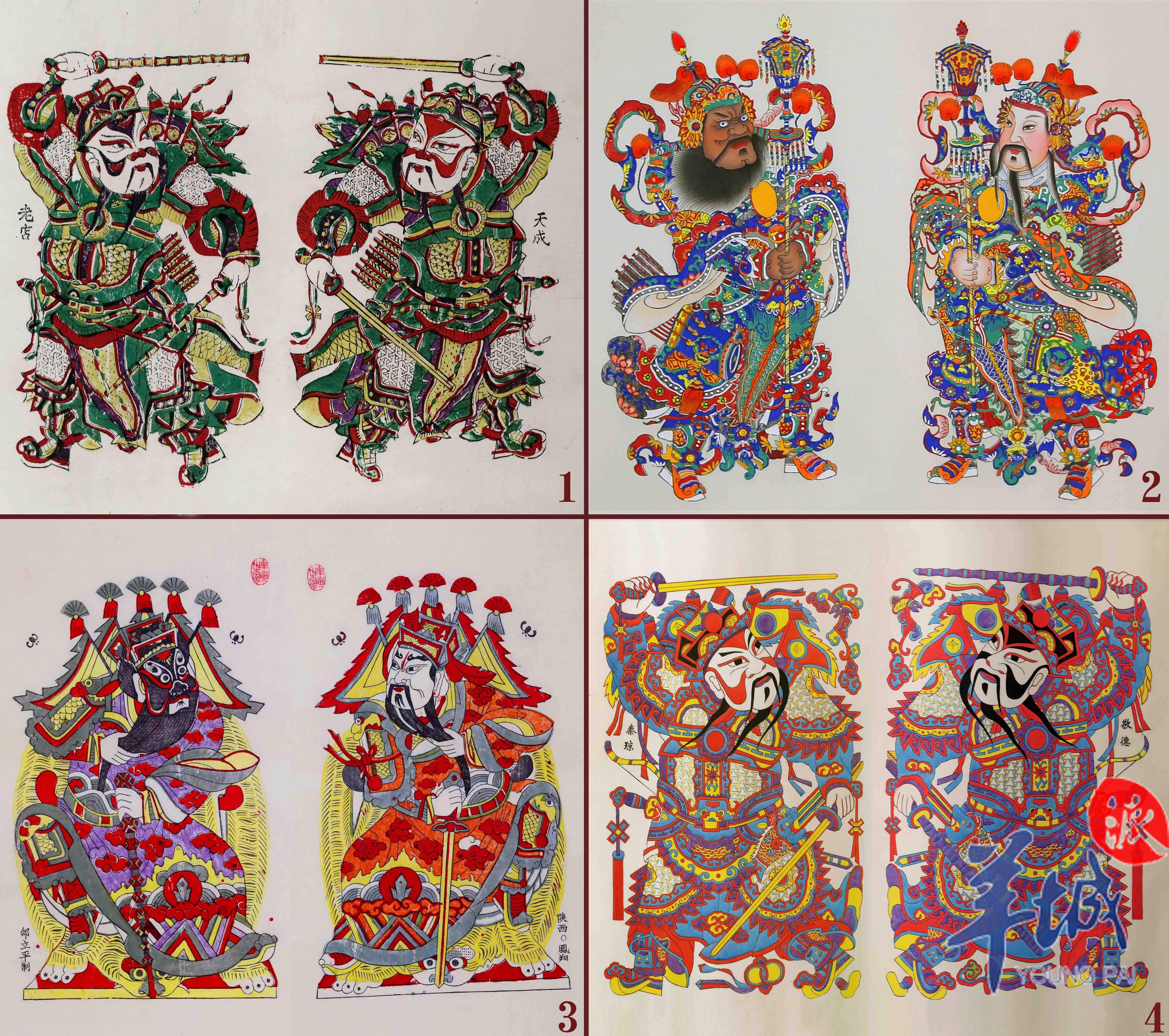 The earliest form of New Year’s painting is the door paintings posted on the door of the New Year, namely the “door god”, which uses colors and techniques in different regions. Figure 1 shows the door god New Year painting created by Yin Guoquan, the national inheritor of Zhuxian Town woodblock New Year painting; Figure 2 shows the door god New Year painting of Yang Liuqing; Figure 3 shows the door god New Year painting created by Tai Liping, the national inheritor of Fengxiang woodblock New Year painting; Figure 4 shows the door god New Year painting created by Yang Fuyuan, the national inheritor of Yangjiabu woodblock New Year painting.
The earliest form of New Year’s painting is the door paintings posted on the door of the New Year, namely the “door god”, which uses colors and techniques in different regions. Figure 1 shows the door god New Year painting created by Yin Guoquan, the national inheritor of Zhuxian Town woodblock New Year painting; Figure 2 shows the door god New Year painting of Yang Liuqing; Figure 3 shows the door god New Year painting created by Tai Liping, the national inheritor of Fengxiang woodblock New Year painting; Figure 4 shows the door god New Year painting created by Yang Fuyuan, the national inheritor of Yangjiabu woodblock New Year painting.
Zhuxian Town, Kaifeng
Having a precedent for woodblock New Year painting
In ancient times, Zhuxian Town was ranked one of the “Four Major Ancient Towns in China”. What made its reputation famous was the woodblock New Year paintings that were popular here and passed down through the ages. Zhuxianzhen woodblock New Year paintings, as an outstanding representative of traditional Chinese art, have been included in the first batch of national intangible cultural heritage list.
The day I went to Zhuxian TownKomiks was catching up with a rare heavy snowfall in Kaifeng. The flying snowflakes in the sky made the morning of the ancient town less noisy, and the sight of the eyes was the accumulation of snow in front of some shops and vendors in front of the door. This ancient town that has been covered with wind and rain for thousands of years cannot imagine its glory.
The Yuewang Temple, which was built here during the Ming Dynasty, is located on the side of Yuemiao Street. It is a wooden New Year painting street in the ancient town. Now many old wooden New Year painting brands have been restored. On this old street, you can not only feel the charm of the traditional wooden New Year paintings, but also spend a few dozen yuan to buy valuable works by the New Year painting craftsmen.
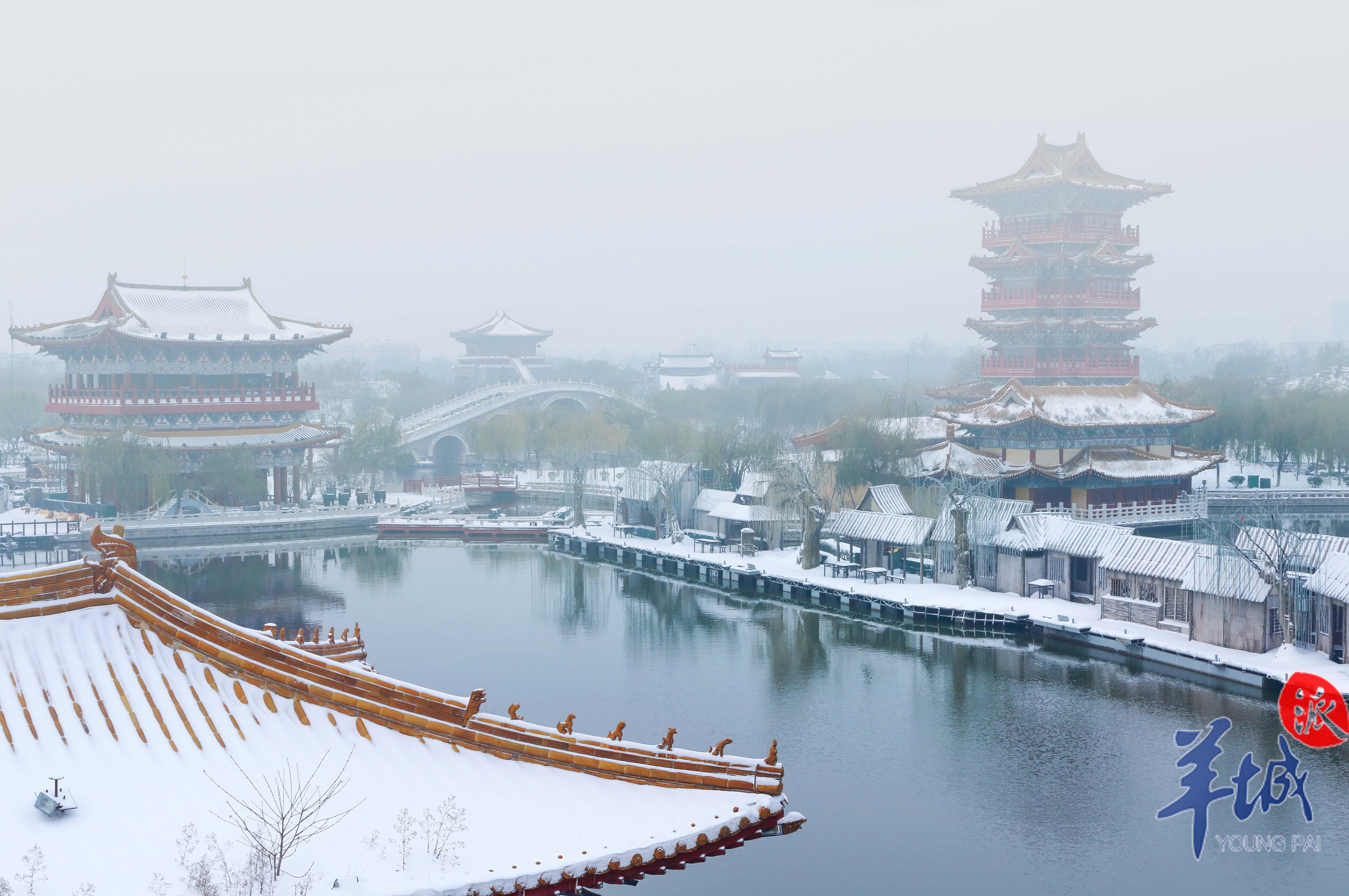
According to historical records, Zhuxian Town Wooden New Year paintings, known as the “ancestor of Chinese woodblock New Year paintings”, was born in the Tang Dynasty and flourished in the Song Dynasty. During the Ming and Qing Dynasties, it reached more than 300 New Year painting workshops. The opening of the canal made Zhuxian Town a commercial center in the Central Plains, and the sales of New Year paintings flourished. Many merchants gathered here from the current Shandong, Jiangsu, Anhui, Fujian, Ningxia and other regions to buy two-thirds of the country’s New Year paintings.
The prosperity of Zhuxian Town Wooden New Year paintings is inseparable from the fertile land of Kaifeng. Kaifeng during the Northern Song Dynasty was the center of politics, economy, and culture in the country, and a huge citizen classCinema layer activates the demand for folk culture and provides rich soil and market for the creation of New Year pictures.
Meng Yuanlao’s “Dream of Tokyo” records that “in recent years, the market has printed door gods, peach boards, peach talismans, etc. “On the River During the Qingming Festival” which depicts the social life of the Northern Song Dynasty, the guise of the “Wang Family Paper Horse” shop near the beginning of the volume is clearly identifiable.
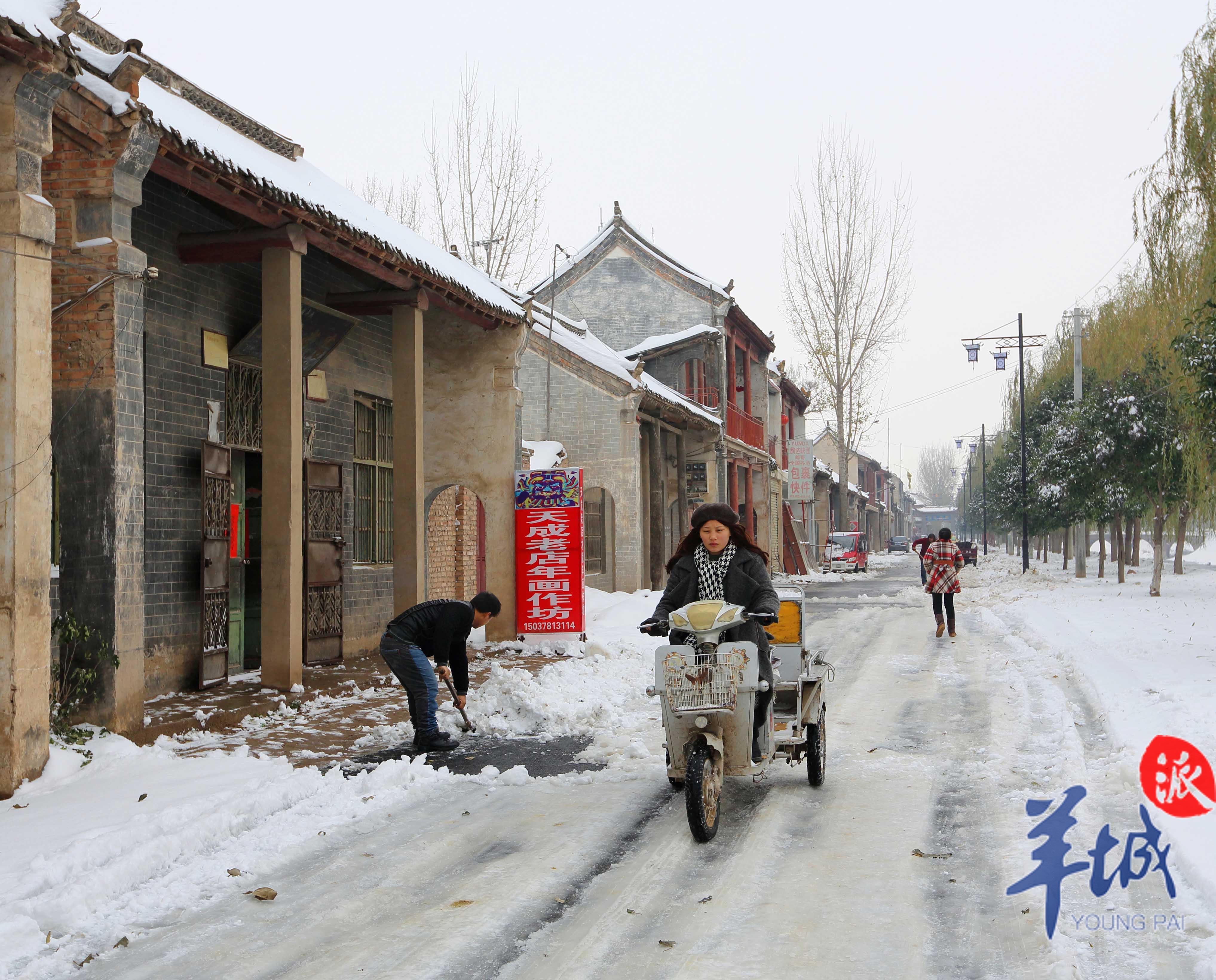
Strive on a New Year’s Painting Street, closely adjacent to the ancient canal, the old houses on both sides are mottled, and the rugged eaves show the vicissitudes of the years it has experienced, and the original taste is full of nostalgia.
A two-story shop has a high “profile” with black background and yellow characters, and the letter “Tiancheng Old Shop”. The old house with peeling paint has no decoration, and the four walls are full of New Year’s paintings, with the mighty door god, the iron-faced and curly bearded Zhong Kui’s head, the fifth son wins the championship, the pine crane and the longevity of the lotus, the precious son of the lotus, the fifth generation descendant of the “Tiancheng Old Shop”, the old man in his seventies, is full of New Year’s paintings. Komiks sat in a simple manner in front of the stage where various colors of paint were piled up. With the help of his grandson, he repeatedly applied different paints and printed New Year pictures in color. It took the old man a month to place a newly engraved set of carved papers on the stage. The iron rack next to it was full of colorful greens, and the New Year pictures that had just been printed and dried were very beautiful. Behind the counter was Old Yin’s Babaylan, with the production table connected to the counter, a typical traditional workshop.
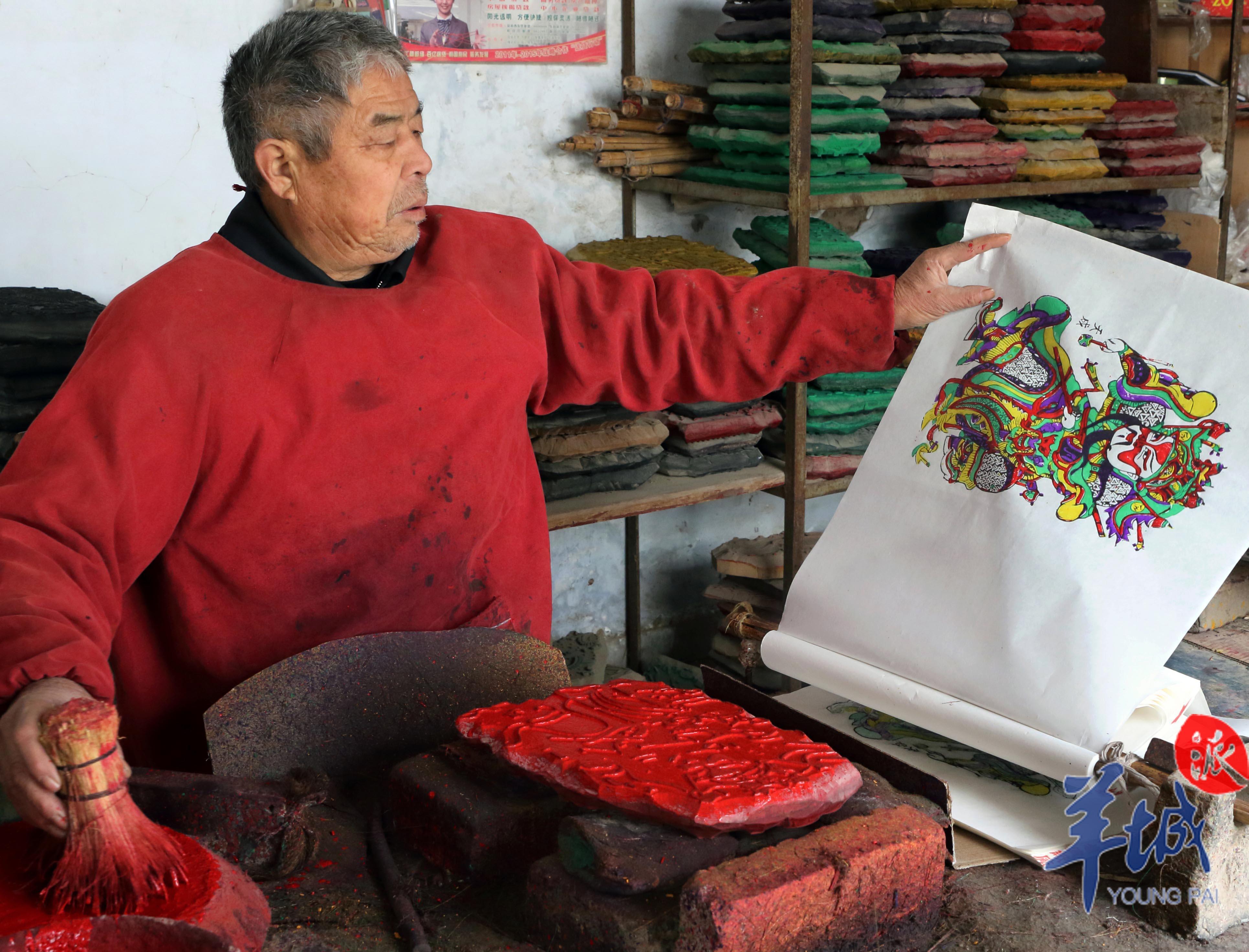 Every year, it begins to enter the peak period of New Year’s painting production. The picture shows Yin Guoquan, who is fully focused on printing New Year’s paintings. In Yin Guoquan’s view, the authentic traditional skills are facing the danger of losing. Over the past few decades, he has created more than 300 sets of carved plates and more than 1,500 pieces. He said: “The pigments I printed in New Year’s paintings are carefully processed and boiled with plants such as pine smoke, locust rice, and Zhangdan. Although it takes time and effort, it is correct in color compared to the current industrial pigments. ”
Every year, it begins to enter the peak period of New Year’s painting production. The picture shows Yin Guoquan, who is fully focused on printing New Year’s paintings. In Yin Guoquan’s view, the authentic traditional skills are facing the danger of losing. Over the past few decades, he has created more than 300 sets of carved plates and more than 1,500 pieces. He said: “The pigments I printed in New Year’s paintings are carefully processed and boiled with plants such as pine smoke, locust rice, and Zhangdan. Although it takes time and effort, it is correct in color compared to the current industrial pigments. ”
”The things passed down by the older generation cannot be lost. My two sons and grandsons are heirs. “Looking at his hands that are slightly rougher than ordinary people, and the wrinkles on his face being gullyed by the years, a kind of shock filled his heart.
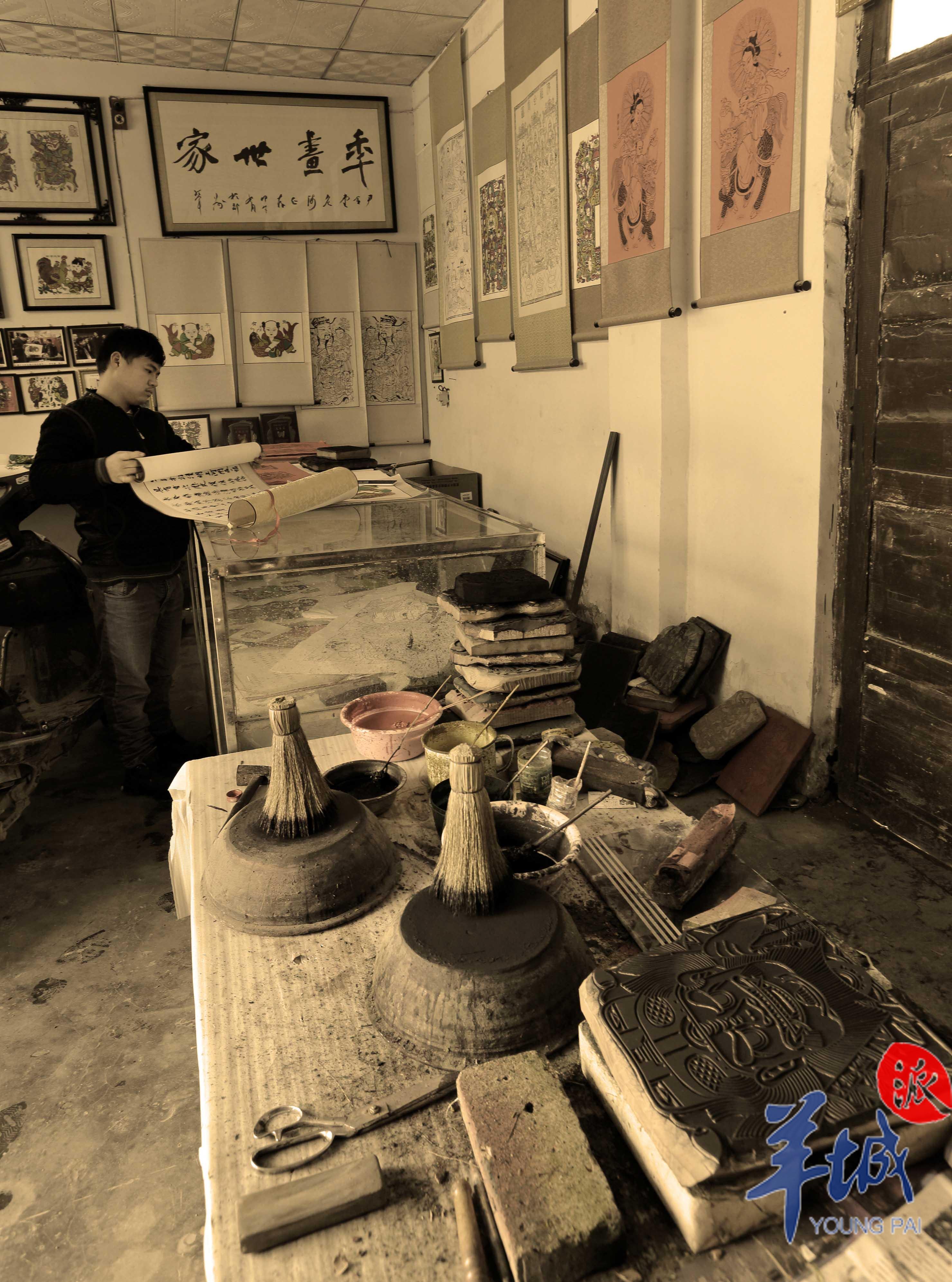 The “Tiancheng Old Shop” connected to the counter of the production station is full of vicissitudes of time. The content of the woodblock New Year pictures in Zhuxian Town is mostly based on familiar historical stories and myths and legends. The printing technique is mainly woodblocked water-color overprinting, six versions, and some are Babaylan to nine editions. The red, yellow, green and purple colors are bright and exaggerated. The characters have big heads and small bodies, and look rustic and cute. Most characters have white faces and red eyelids on their faces. This is its unique technique and is also the representative style of Zhuxian Town woodblock New Year pictures.
The “Tiancheng Old Shop” connected to the counter of the production station is full of vicissitudes of time. The content of the woodblock New Year pictures in Zhuxian Town is mostly based on familiar historical stories and myths and legends. The printing technique is mainly woodblocked water-color overprinting, six versions, and some are Babaylan to nine editions. The red, yellow, green and purple colors are bright and exaggerated. The characters have big heads and small bodies, and look rustic and cute. Most characters have white faces and red eyelids on their faces. This is its unique technique and is also the representative style of Zhuxian Town woodblock New Year pictures.
The vigorous and ancient lines, simple and symmetrical patterns, and rough and thick atmosphere reflect the strong local art style of Zhuxian Town in the heart of the Central Plains. Mr. Lu Xun once commented on Zhuxian Town woodblock New Year pictures, “These woodblocks are simple, with thick and powerful engravings, and they are not stained with powder. The characters have no charm, and the colors are strong and very local. ”
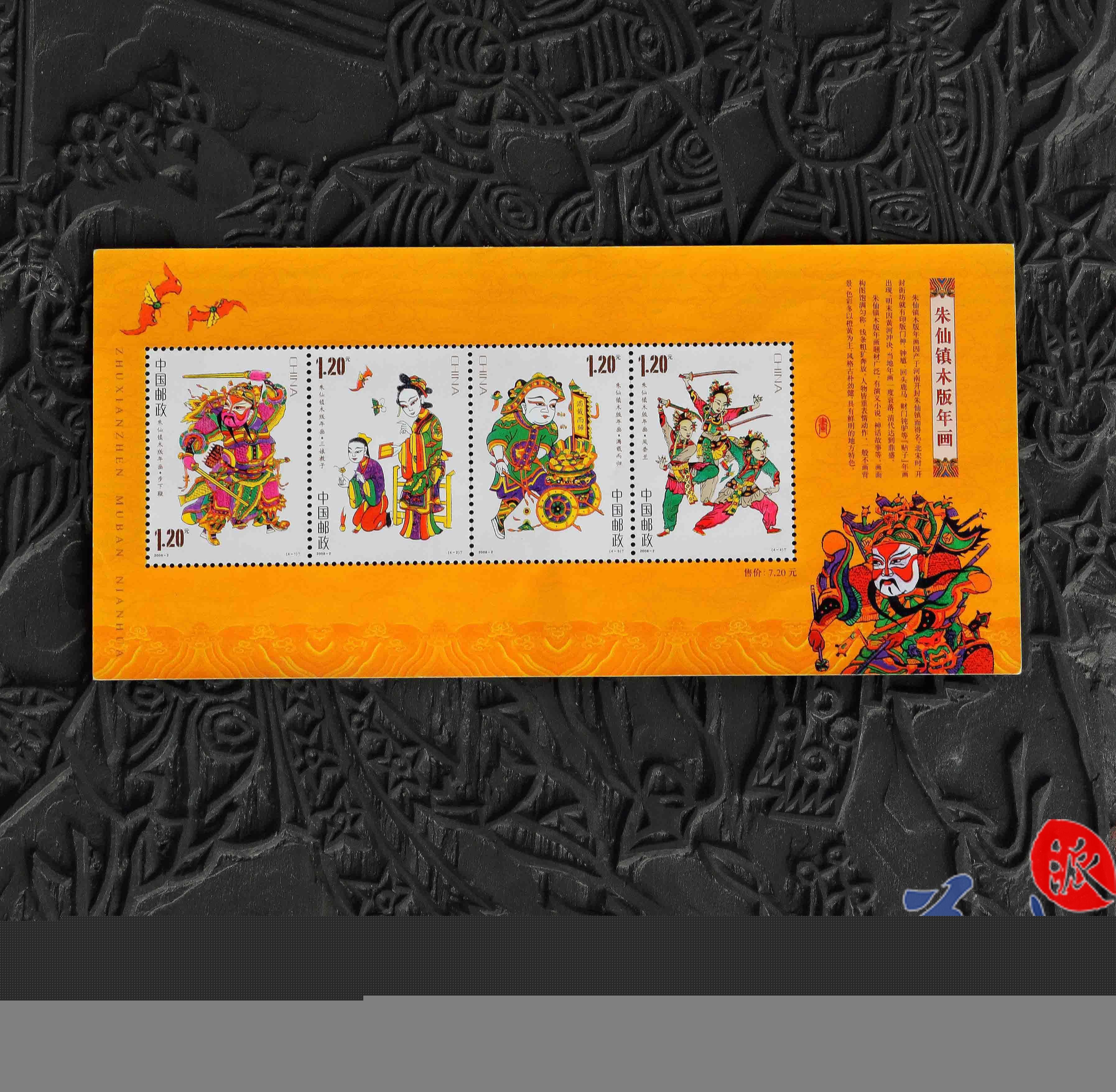 The special stamp of “Zhuxian Town Wooden New Year Pictures” issued in 2008 is taken from the classic story “Sanniang teaches children, returning home with a full load, and Fengxianglan.
The special stamp of “Zhuxian Town Wooden New Year Pictures” issued in 2008 is taken from the classic story “Sanniang teaches children, returning home with a full load, and Fengxianglan.
The real-life theme park Qingming Shanghe Park, which was opened to the public in 1998, is located on the west bank of Longting Lake, Kaifeng City. It is a large historical and cultural park with the theme of Song culture as the model. It is now a 5A scenic spot.
The wood-panel New Year pictures in Zhuxian Town are sold all year round. In the retro New Year picture shop, you can learn about the production of traditional wood-panel New Year pictures. Visitors can not only appreciate and purchase, but also participate in the interaction on the spot.
 In the ancient and vigorous Zhuxian Town woodblock New Year pictures, red, yellow, green and purple are colorful and rich, with exaggerated characters, big head and small body, looking rustic and cute
In the ancient and vigorous Zhuxian Town woodblock New Year pictures, red, yellow, green and purple are colorful and rich, with exaggerated characters, big head and small body, looking rustic and cute
Suzhou Taohuawu
Carrying beautiful expectations
The ancient city of Suzhou is gentle and colorful, extending for thousands of years, giving Taohuawu woodblock New Year paintings a brilliant and elegant character. The Yongzheng and Qianlong periods of the Qing Dynasty were the most prosperous period of Taohuawu New Year paintings. There are hundreds of painters and printing craftsmen gathered here. The New Year paintings are sold to Southeast Asia. “Taohuawu” has become synonymous with Suzhou woodblock New Year paintings.
Looking through some books recording Suzhou’s cultural tourism or walking in historical districts such as Shantang Street and Pingjiang Road, you can see the shops of “Taohuawu New Year paintings”. There is also a Taohuawu Street in Suzhou. href=”https://comicmov.com/”>Babaylan is a stone road that is not wide, with houses with pink walls and black tiles arranged on both sides. The hanging lanterns and Spring Festival couplets exude the joy of the New Year.
In the shops on Taohuawu Street, it is not difficult to find the shadow of the New Year paintings. In the Puyuan of Xiaochangqiao Road, which intersects Taohuawu Street, I found the Taohuawu Woodcut New Year Painting Museum. Walking in, a fresh and elegant garden comes into view, and the New Year Painting Museum is quietly hidden in the lush green shade.
 A family in Suzhou can be painted by people. The museum currently collects hundreds of ancient New Year pictures collections. The picture of the word “Fu” and “Flowers Blooming and Rich Flowers”, which are displayed in the bedroom. In the real scene display part, “Three Stars Highlights” and “Eight Immortals Crossing the Sea”, which means that there are many guests; the bedroom is pasted with “Flowers Blooming and RichnessCinema” “Give a noble son early” means the harmony of husband and wife. These New Year pictures that reflect the living conditions of the people in ancient times are loved by modern people.
A family in Suzhou can be painted by people. The museum currently collects hundreds of ancient New Year pictures collections. The picture of the word “Fu” and “Flowers Blooming and Rich Flowers”, which are displayed in the bedroom. In the real scene display part, “Three Stars Highlights” and “Eight Immortals Crossing the Sea”, which means that there are many guests; the bedroom is pasted with “Flowers Blooming and RichnessCinema” “Give a noble son early” means the harmony of husband and wife. These New Year pictures that reflect the living conditions of the people in ancient times are loved by modern people.
I saw a table with engraving, engraving platform, printing platform, brown brush, brown rub, fist knife and other engraving tools. Several inheritors in their early thirties were engraving meticulously. Holding a knife in their right hand, skillfully carving lines on the woodblock, sweat ejaculated from the tip of their nose, but they didn’t care to wipe it off, and their concentration was like making the most precious treasure in the world.
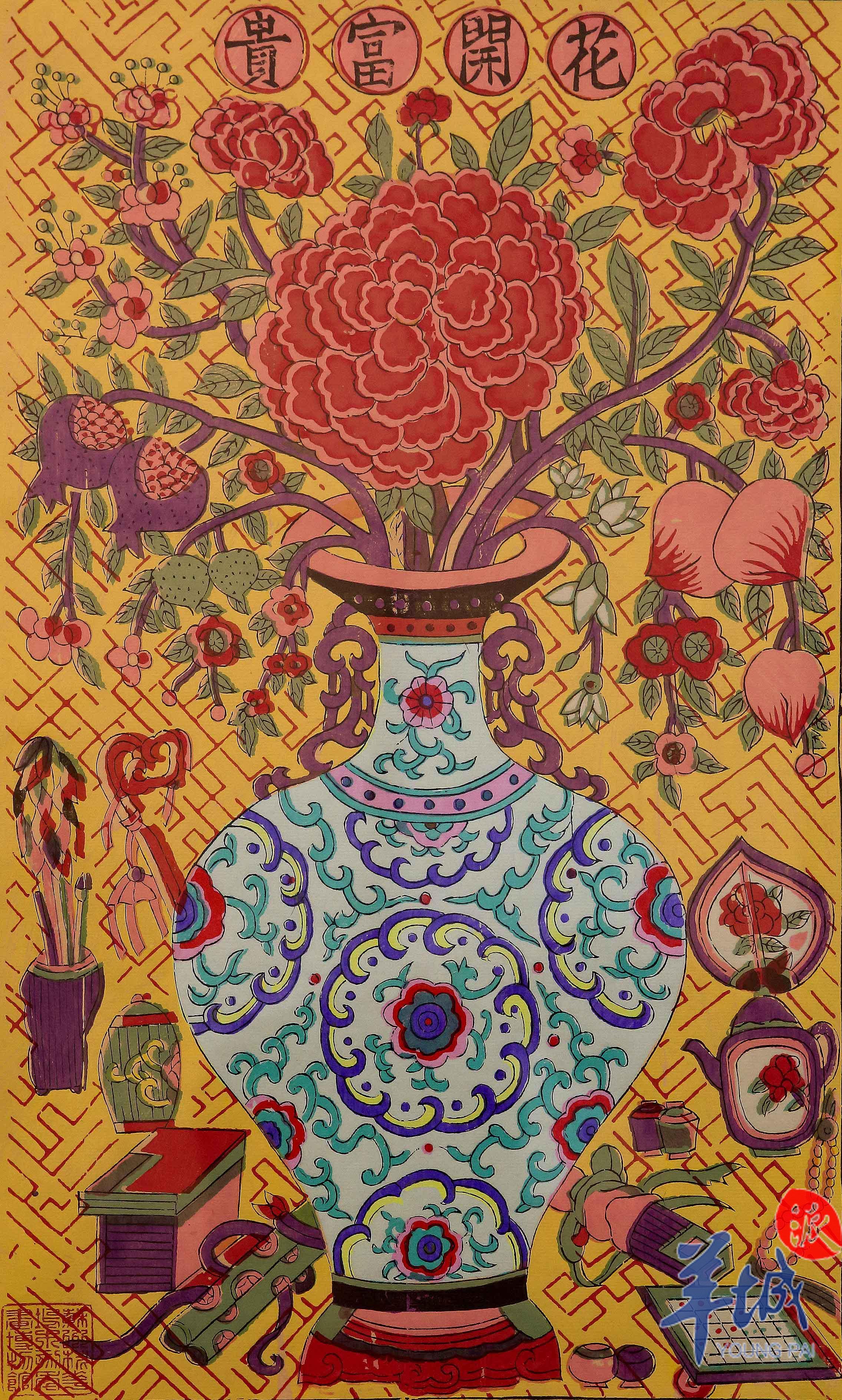 The ancient Taohuawu historical classic woodblock New Year painting “Flowers Bloom and Rich”
The ancient Taohuawu historical classic woodblock New Year painting “Flowers Bloom and Rich”
According to reports, a Taohuawu woodblock New Year painting is not completed by a painter alone. It requires three steps to draw, engrave and print, and is created by a collective creation. Compared with New Year paintings in other regions, the characteristic of Taohuawu New Year painting is that it relies entirely on the printing. There is no stroke after printing, and it is known for its engraving.
A fist knife that is just clenched by the palm can evolve into four methods: starting knife, placing knife, picking knife, and re-knife. It pays attention to “precise knives, picking knife, and shoveling the bottom”. The lines should be engraved naturally and vigorously, clean and neat. Generally speaking, it takes 5 years to learn Taohuawu New Year paintings, engraving for 4 years, and printing for 2 years.
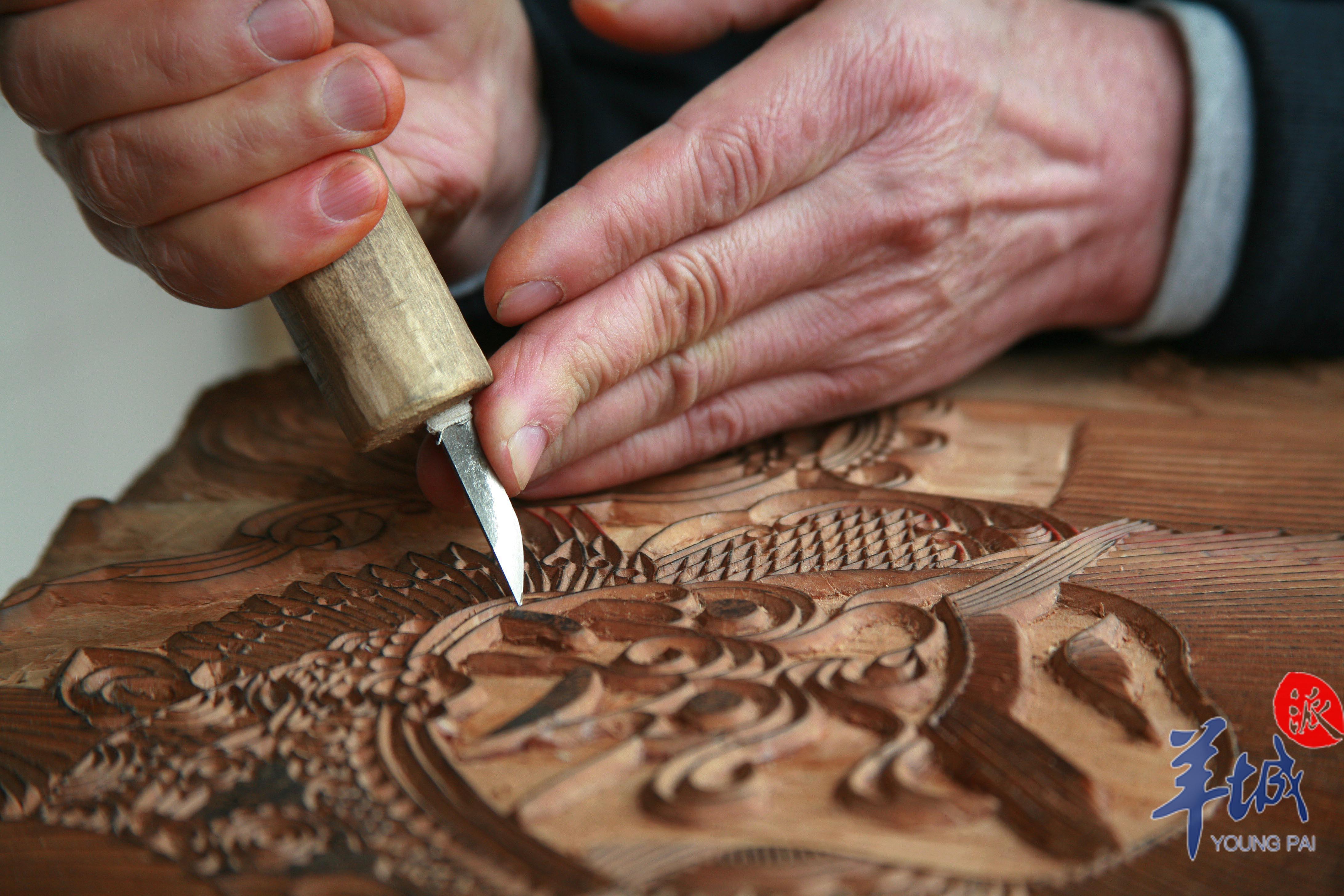 One of the main steps of traditional Chinese woodblock New Year paintings
One of the main steps of traditional Chinese woodblock New Year paintings
In early 2008, a New Year painting “A Tube of Harmony” created during the Yongzheng period of the Qing Dynasty was successfully reproduced in Puyuan. This can be called the classic work of Taohuawu New Year paintings. “A Tube of Harmony” warns the people of the palace to live in harmony and spread to the people’s desire to unite and fulfill their wishes.
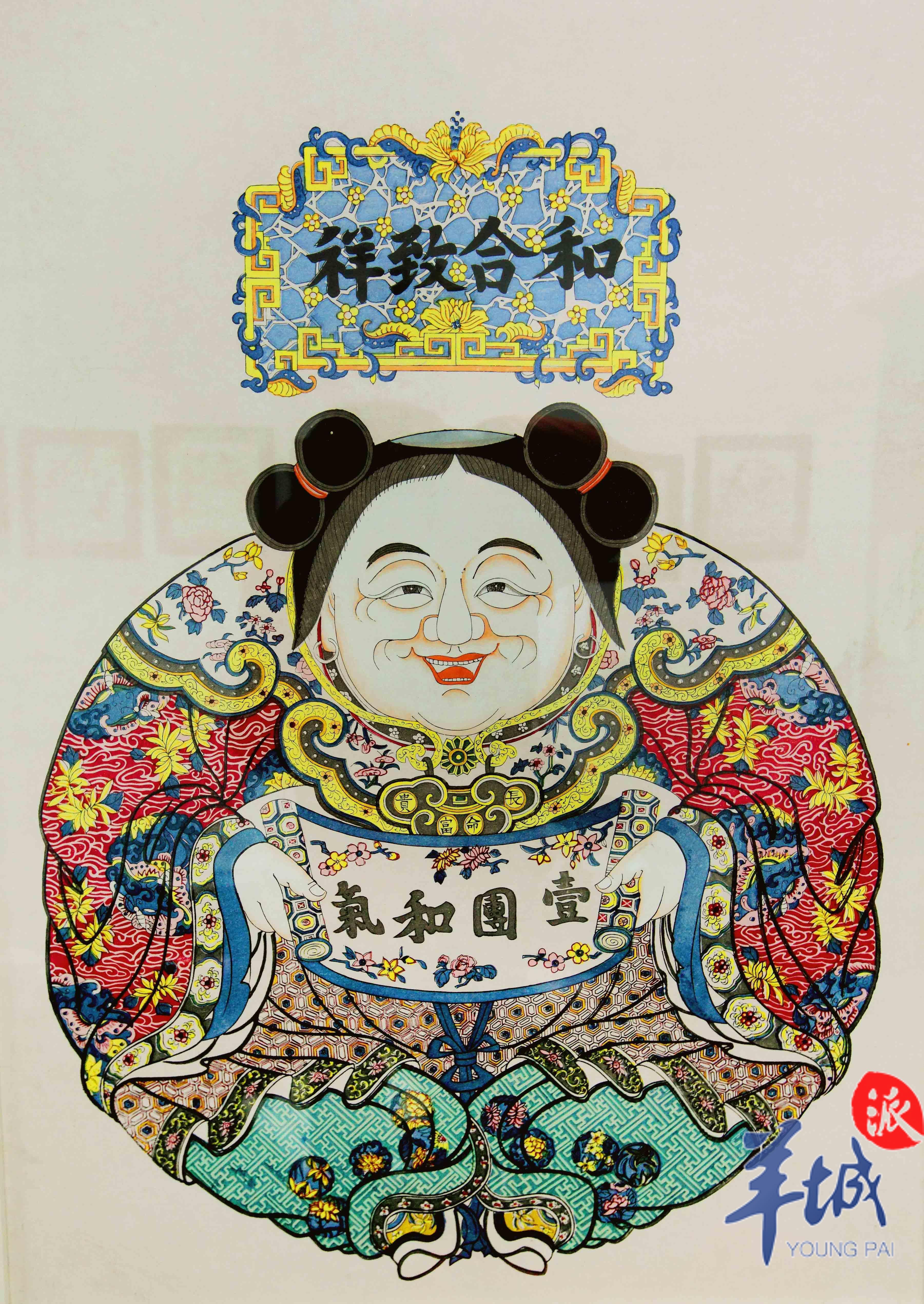 《A Mutual Qi” is one of the representative works of Taohuawu woodblock New Year paintings
《A Mutual Qi” is one of the representative works of Taohuawu woodblock New Year paintings
Since history, Taohuawu woodblock New Year paintings have carved a unique folk custom, that is, from content to social effects, called woodblock New Year paintings, but not limited to New Year postings and hangings. Instead, in accordance with the seasons, when different festivals and solar terms come every year, woodblock New Year paintings should be used to express different beautiful expectations.
For example, when bidding farewell to the old and welcoming the new, “Happy Picture” is posted; when the beginning of spring, you should post “Mingyuan Picture”; when the Mid-Autumn Festival, you should post “Moon Palace Picture”… and when you post, the new year is coming again.
Tianjin Yangliuqing
So deeply influenced by multiculturalism
During the Spring Festival, when we came to Yangliuqing Town, Xiqing District, Tianjin, antique buildings with carved beams and painted buildings immediately came into view. The frozen ancient canal quietly “hibernates” in the town, and several beautiful arch bridges span the ice surface. Tianjin Yangliuqing, surrounded by Ziya River, Nanyun River, and Daqing River, was an important wharf for the north-south cargo circulation and overseas trade during the Ming and Qing Dynasties. Yangliuqing woodblock New Year pictures were therefore deeply influenced by multiculturalism.
p>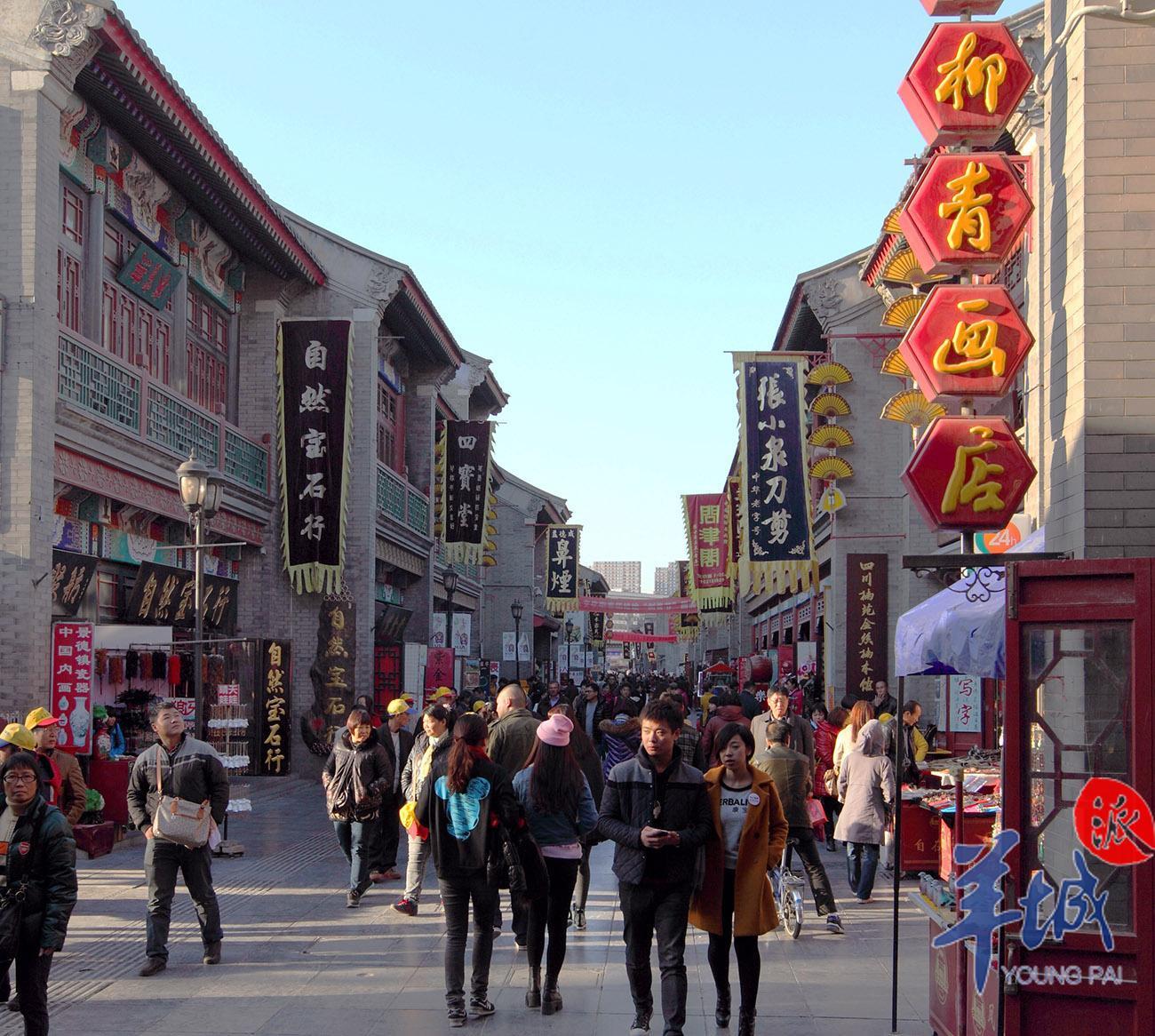 Tianjin Ancient Cultural Street is a Scenery
Tianjin Ancient Cultural Street is a Scenery
According to historical records, Yangliuqing Chinese painting first appeared in the Wanli period of the Ming Dynasty, and reached unprecedented prosperity during the Qianlong period of the Qing Dynasty. In 1958, the state established the Yangliuqing Painting Club to rescue the New Year painting art, collected and organized Yangliuqing Paintings, and cultivated a group of outstanding New Year painting artists. In recent years, with the prosperity of the cultural tourism market, the demand for Yangliu Youth painting has expanded, bringing this ancient folk art back to the lives of the people. At the same time, Yangliu Youth Painting has also entered the international art sales and collection market.
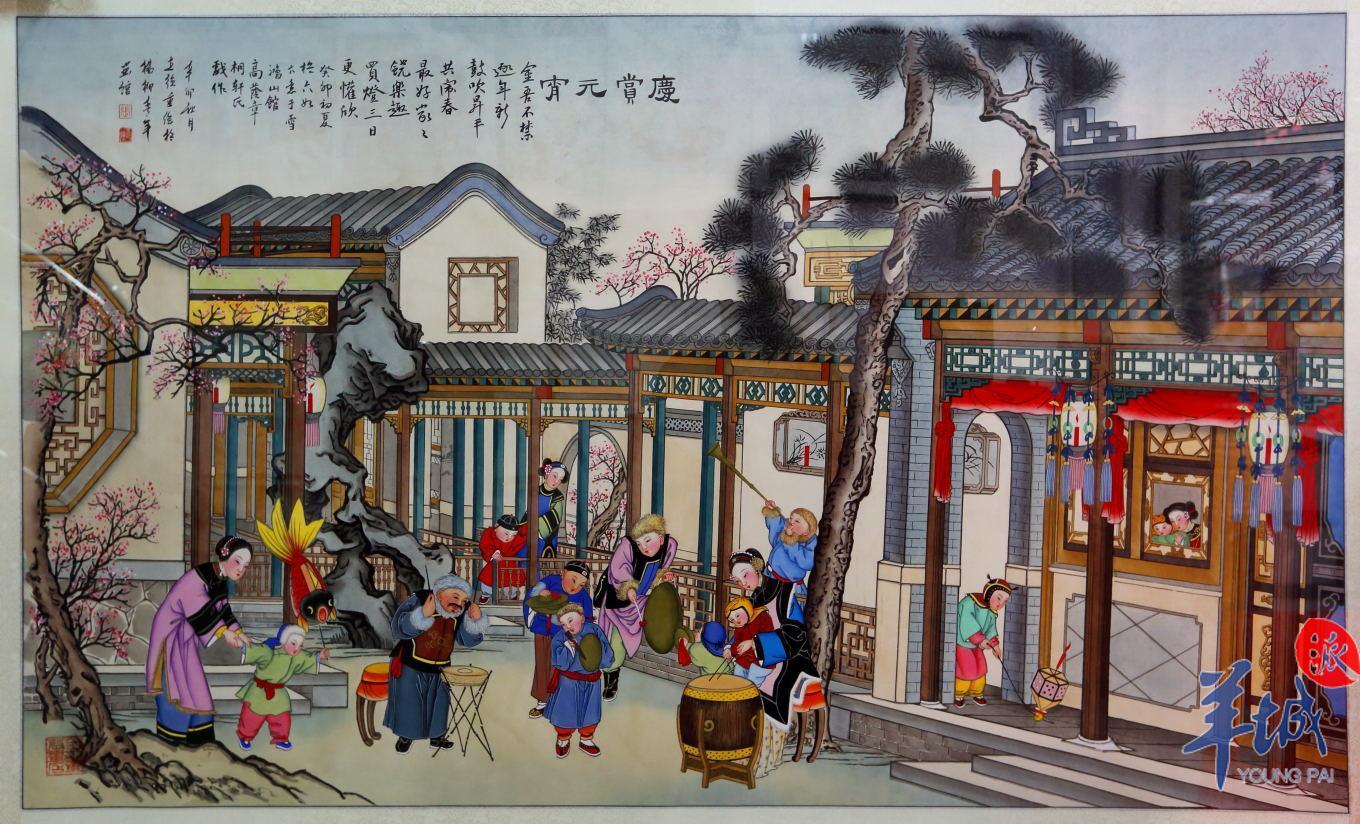
If Taohuawu New Year paintings are like implicit and beautiful beauty, then Yangliuqing New Year paintings are lively and straightforward men. From the picture of the fat baby with a carp in the arms and lotus in the hands of the body to the three-star picture of the lucky and lucky life, a unique style of being vivid, joyful and full of emotions has been created.
Yangliuqing Nian Painting inherited the tradition of Song and Yuan paintings and absorbed the forms of woodcuts, arts and crafts, and drama stages in the Ming Dynasty. The early craftsmanship is basically the same as Taohuawu New Year paintings, and both use the stereotyped overprint of the drawings; in the post-production, it takes a lot of time to be used for hand-painting.
 Yangliuqing Nian Painting Five Sons Take Lotus was once selected as a stamp.
Yangliuqing Nian Painting Five Sons Take Lotus was once selected as a stamp.
A New Year’s painting requires five main processes: drawing, carving and drawing, woodblock overprinting, hand-painting, and mounting, plus more than three monochrome overprinting. Because of the combination of printing and painting, it has a quiet, elegant and lively visual effect, which is beyond the reach of other folk New Year pictures.
The content of the picture is mainly folk life, fat dolls, maids and historical stories. The most classic one is “After Years of Life”, the doll in the painting has a baby face and a Buddha body, a playful posture, a martial arts stand, a carp in his arms, and a lotus in his hands, which caters to the folk “praying for blessings and welcome good fortune”The beautiful wish of “more children and more blessings”.
 Yangliuqing Door God New Year’s Painting
Yangliuqing Door God New Year’s Painting
On the antique Ming and Qing Streets, Yuchengha, Yichengyong, Gu Liuxiang, Huayunzhai and others are dazzling. New Year’s painting workshops are one by one, and there are more than 60 New Year’s painting production workshops and sales stores in Yangliuqing Town. It is one of the best New Year’s paintings that have been restored. It seems that it has returned to the scene of “drawing every family and painting every household” during the Qianlong period of the Qing Dynasty. Tourists buying New Year’s paintings are endless all year round.
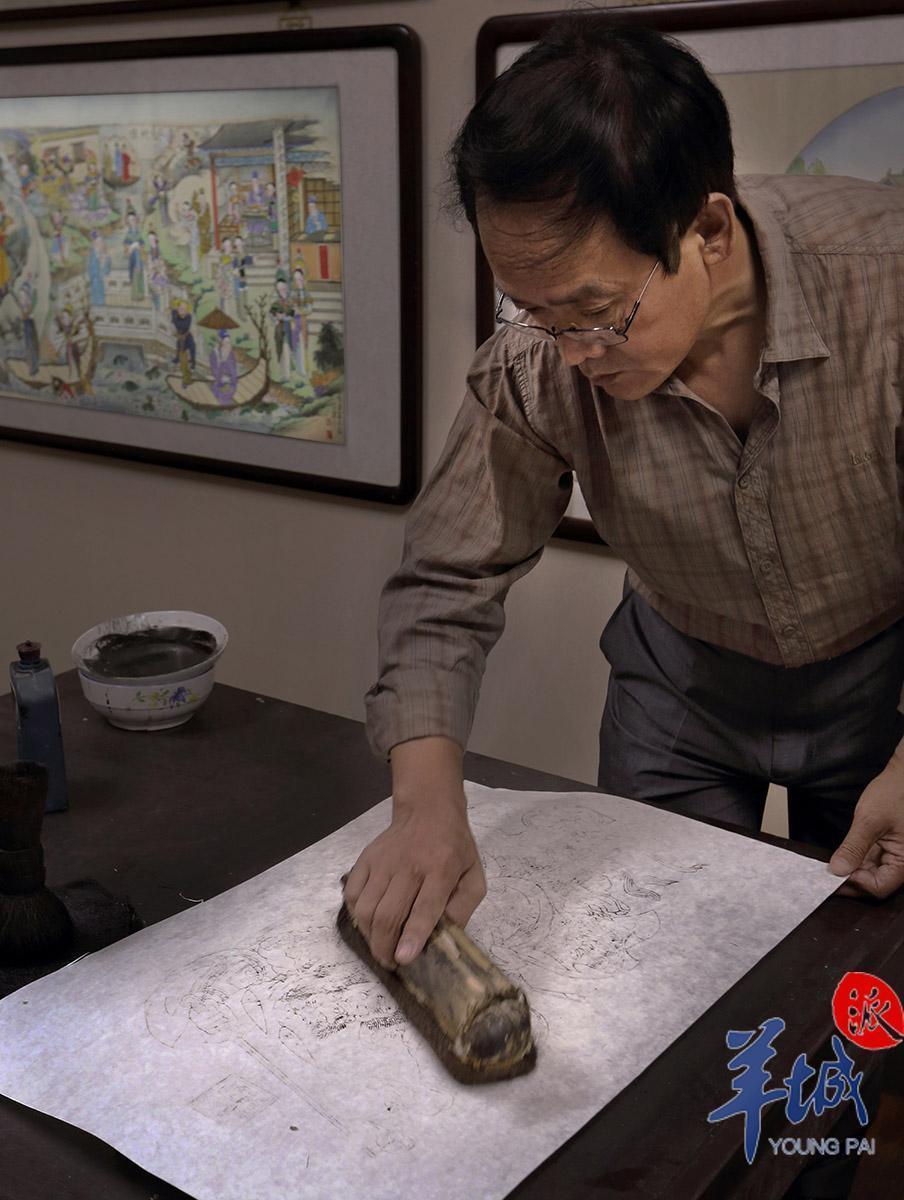
The first woodblock New Year painting museum in Yangliuqing Town holds a series of activities “Appreciating New Year paintings and observing folk customs” every year in the first month.
In the northern house in the exhibition hall on the first floor of the museum, there is a “Kitchen God” on the stove that represents the sayings of good things from heaven and the safety of the land; there is a big carp that represents more than a year and has a lively and vivid shape; there is a painting of the three-star middle hall of blessings and longevity in the middle of the main hall to protect the whole family; there is a painting of the upper house where the mother-in-law lives is attached to the upper house where the mother-in-law lives is attached to the New Year pictures with educational significance; the lower house where the daughter-in-law lives is attached to the New Year pictures with many children and blessings; there is a painting of the kang with strong local flavor on the side of the kang. Visitors to the museum can also experience the production process of woodblock New Year pictures.
Walking out of the museum, what I impressed most is the splendor of the Willow Youth New Year paintings. It is unforgettable to remember the local people’s persistence in “only posting New Year pictures is considered to be the New Year.”
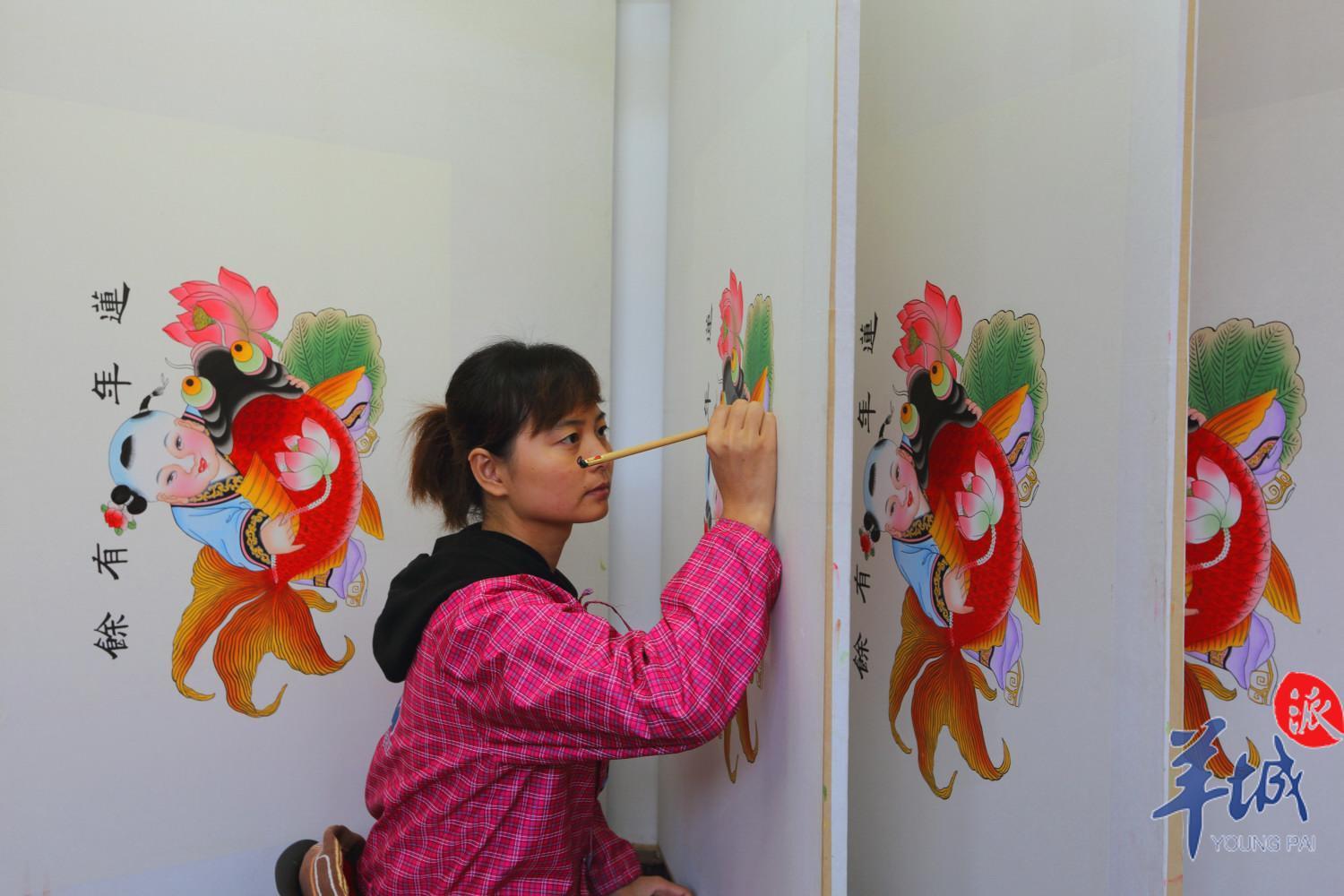 Yangliu Youth Painting takes a lot of effort to use hand-painting. The picture shows the painter of “New Year’s Painting” is focusing on the ending of the classic painting “After Years and More”
Yangliu Youth Painting takes a lot of effort to use hand-painting. The picture shows the painter of “New Year’s Painting” is focusing on the ending of the classic painting “After Years and More”
Now, the improvement and innovation of New Year’s paintings are a new issue faced by older New Year’s painting craftsmen and young painters. Although it takes time and effort, it can be seen that it has a dense taste of life, abundant emotions and aesthetic interests, and the full expression of the Chinese culture and the dreams of Yanhuang for thousands of years.
With more than two thousand years of history, woodblock New Year paintings created by Chinese local artists, it is the oldest type of painting in the world, an encyclopedia of Chinese folk customs and a “living fossil” full of elements of Chinese civilization.
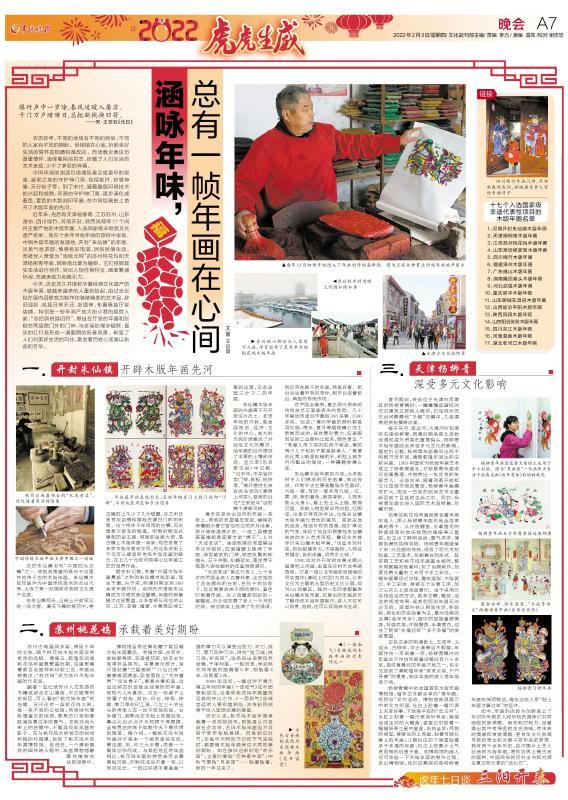 Yangcheng Evening News February 3, 2022 A7 Evening Party Supplement
Yangcheng Evening News February 3, 2022 A7 Evening Party Supplement
Linked
List of 17 woodblock New Year paintings selected as representative national intangible cultural heritage projects
1. Woodblock New Year paintings in Zhuxian Town, Kaifeng, Henan Province:
Simple and naive, with a long history, was born in the Tang Dynasty and flourished in the Song Dynasty, and was the founder of Chinese woodblock New Year paintings.
2. Tianjin Yangliuqing woodblock New Year painting:
Celebrating the fun of the palace and the interests of the citizens.
 Contains the meaning of auspiciousness and happiness. The Yangliu Youth Painting “Hometown Happy Safe” is “Hometown Sadness”
Contains the meaning of auspiciousness and happiness. The Yangliu Youth Painting “Hometown Happy Safe” is “Hometown Sadness”
3. The woodblock New Year painting of Taohuawu, Suzhou, Jiangsu:
Delicate and craftedCinema is intact, rich in color.
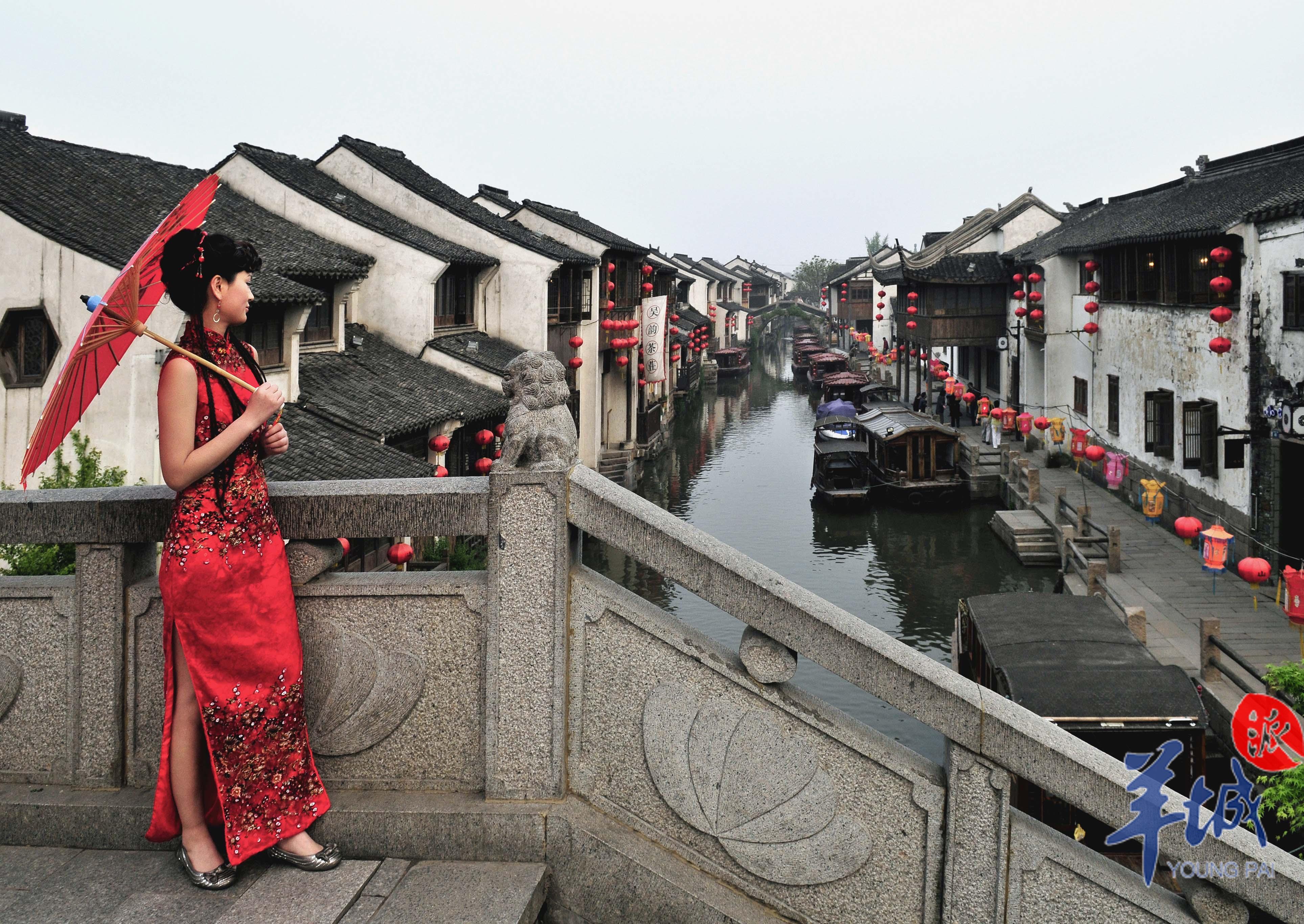 Small bridges and flowing water in Suzhou can be painted, giving birth to the beautiful Taohuawu woodblock New Year pictures
Small bridges and flowing water in Suzhou can be painted, giving birth to the beautiful Taohuawu woodblock New Year pictures
4. CinemaYangjiabu woodblock New Year pictures in Weifang, Shandong:
Not bound by nature, rich imagination, expressing the theme with generalization, romance, symbolism and meaning; the composition is complete, full and symmetrical; the shape is exaggerated, concise and simple. href=”https://comicmov.com/”>KomiksReal.
5. Sichuan Mianzhu woodblock New Year pictures:
The writing is rich in meaning and colorful.
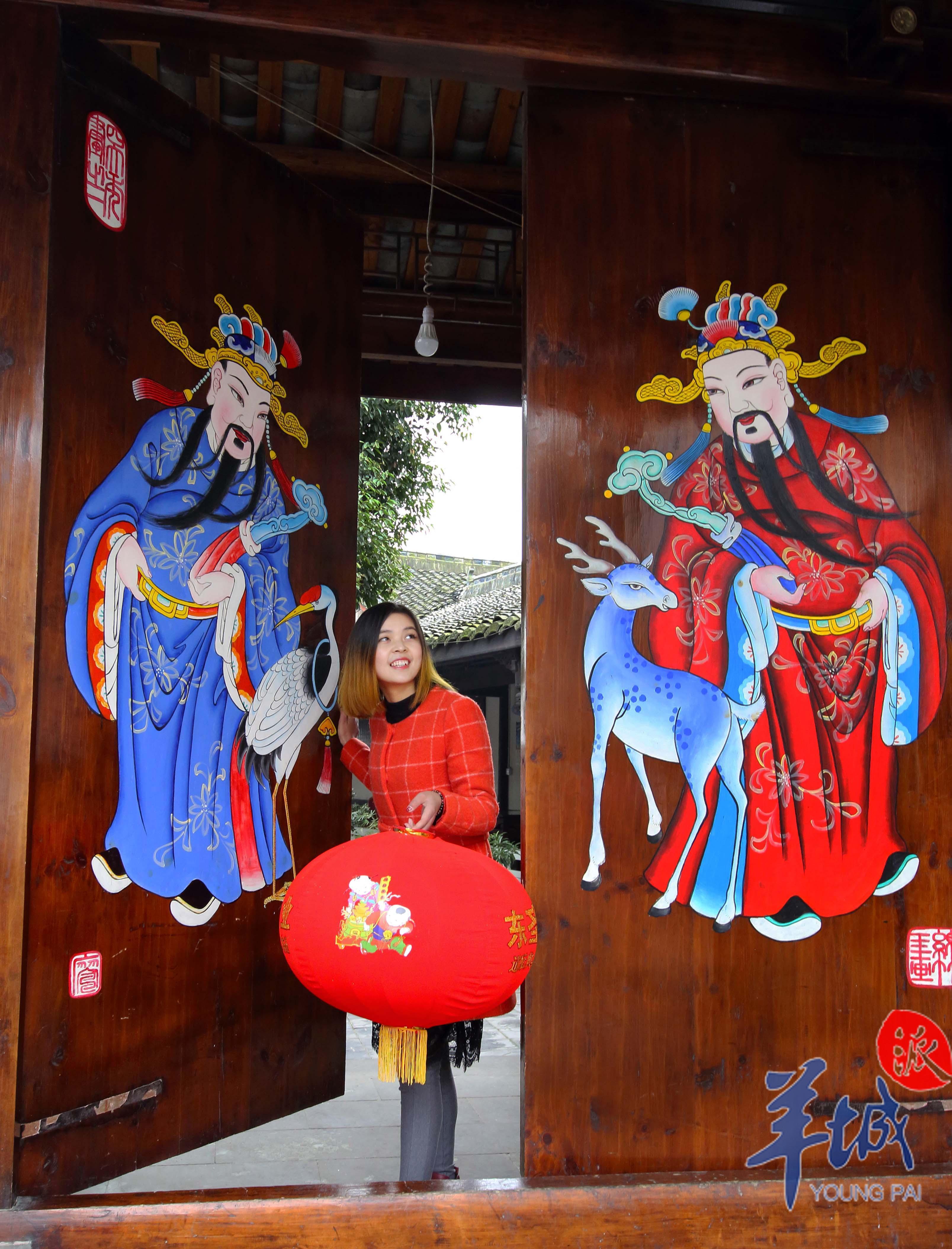
6. Wooden New Year Pictures of Zhangzhou, Fujian:
The region has rich colors, and the themes of gods and Buddhas are rich and diverse.
7. Wooden New Year paintings in Foshan, Guangdong:
The image is delicate, rough and concise, strong and powerful, full composition, and auspicious, extremely Komiks has strong local characteristics.
8. Wooden New Year Pictures of Longhui Tantou, Hunan:
Use unrestrained colors, eye-catching orange, matching close colors, round lines, strong sense of movement, and strong decorative flavor.
9. Wooden New Year Pictures of Wuqiang, Hebei:
Rough and simple, full of rural atmosphere.
10 , Chongqing Liangping Wooden Paper New Year Pictures:
The shape is vivid and lively, the color contrast is strong, and it is full of life atmosphere.
11. Shandong Liaocheng Dongchangfu Wooden Paper New Year Pictures:
The composition is simple, the overall sense is strong, the characters are exaggerated, full and simple; the lines are round and smooth
12. Shanxi Linfen Pingyang Wooden Paper New Year Pictures:
The shape is exaggerated, the image is vivid, and the decorative is strong. Cinema
13. Shaanxi Fengxiang Wooden Edition New Year Pictures:
The style is rough and exaggerated, with large blocks of colors, dynamic characters, and powerful.
14. Shandong Yanggu Zhangqiu Wooden Edition New YearKomiksPaintings:
Composition is full, symmetrical and quaint.
15. Sichuan Jiajiang Wooden New Year Pictures:
Bright colors and exquisite craftsmanship, and were as famous as Mianzhu New Year Pictures and Liangping New Year Pictures.
16. Henan Huaxian Wooden New Year Pictures:
The printing process is detailed and complicated, the composition of the picture is balanced and symmetrical, the image is full and solid, and the lines are strong and powerful.
17. Hubei Laohekou Wooden New Year Pictures:
The carvings are fine and smooth, the lines are rough and powerful, and the characters are vivid and exaggerated.